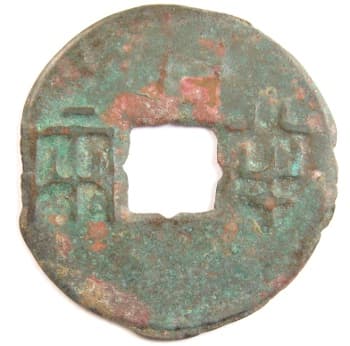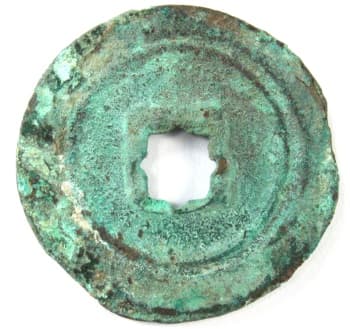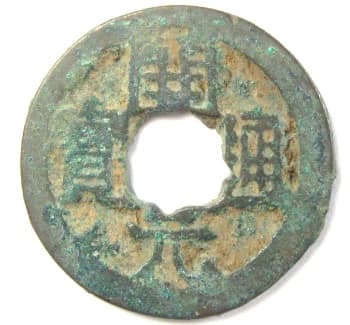
Chinese Coins with Flower (Rosette) Holes

Beginning in the late Zhou
Dynasty and extending through the last days of the Empire,
most Chinese coins retained a
familiar round shape with a square hole in the middle.
As they were cast in large numbers and varieties by numerous
dynastic Emperors, the square central hole coins experienced
small changes such as being slightly larger, smaller,
elongated, misshaped or filled with some excess metal from the
casting. In general, however, these cash coins
maintained a consistent appearance which made them 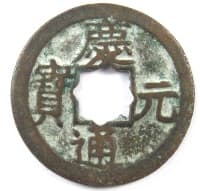 easily recognized as
distinctively "Chinese" for more than two millennia.
easily recognized as
distinctively "Chinese" for more than two millennia.
A fairly small number of these coins, however, were released into circulation having holes with more of an artistic flair such as the example on the left. Instead of the same old four-sided square hole, they would have holes with"eight sides" (octagon) and, because their shape resembled flowers, the Chinese referred to them with such names as flower hole, rosette hole, or chestnut hole. Other coins would have holes with "six sides" (hexagon) and were said to have "turtle shell" holes.
Westerners sometimes refer to these coins as having "star" holes.
While some say that these coins were just the result of accidents or the incompetence of the workers casting the coins, others claim that the flower holes were intentional and have significance.
Images of a number of these coins, along with their production technique and an explanation of their significance, are presented in the sections below.
Traditional Explanation for
Flower Hole Coins -- Mold Shift
 easily recognized as
distinctively "Chinese" for more than two millennia.
easily recognized as
distinctively "Chinese" for more than two millennia.A fairly small number of these coins, however, were released into circulation having holes with more of an artistic flair such as the example on the left. Instead of the same old four-sided square hole, they would have holes with"eight sides" (octagon) and, because their shape resembled flowers, the Chinese referred to them with such names as flower hole, rosette hole, or chestnut hole. Other coins would have holes with "six sides" (hexagon) and were said to have "turtle shell" holes.
Westerners sometimes refer to these coins as having "star" holes.
While some say that these coins were just the result of accidents or the incompetence of the workers casting the coins, others claim that the flower holes were intentional and have significance.
Images of a number of these coins, along with their production technique and an explanation of their significance, are presented in the sections below.
Traditional Explanation for
Flower Hole Coins -- Mold Shift
Chinese Coins Cast in Clay, Stone or Bronze Molds
Unlike Western coinage
which from very early times were produced by being struck
from dies, Chinese coins were not produced in this manner
until very late in the Qing (Ch'ing) Dynasty (1644 - 1911
AD). The very earliest Chinese coins were instead
cast by means of clay, stone or bronze molds.
Ancient Chinese texts have traditionally explained the appearance of flower (rosette) holes as being the result of the two halves of the coin mold accidentally shifting during the casting process. As the molten metal was poured into the mold, if the upper and lower halves of the mold should happen to rotate or shift, the result would be a hole that would not be square.
The problem with this explanation is that not just the hole but everything, including the inscription (legend) and any other symbols on the face of the coin, would also be affected by the movement of the mold halves. Since the inscriptions and other symbols appearing on coins with flower holes are as crisp and distinct as their counterparts with conventional four-sided holes, this traditional explanation is obviously inadequate.
Ancient Chinese texts have traditionally explained the appearance of flower (rosette) holes as being the result of the two halves of the coin mold accidentally shifting during the casting process. As the molten metal was poured into the mold, if the upper and lower halves of the mold should happen to rotate or shift, the result would be a hole that would not be square.
The problem with this explanation is that not just the hole but everything, including the inscription (legend) and any other symbols on the face of the coin, would also be affected by the movement of the mold halves. Since the inscriptions and other symbols appearing on coins with flower holes are as crisp and distinct as their counterparts with conventional four-sided holes, this traditional explanation is obviously inadequate.
Chinese Coins Cast in Sand Molds
Coins with flower
holes began to be commonly seen during the Tang
Dynasty (618 - 907 AD). By this time, hard
clay, stone and metal molds were no longer being used
to cast coins. (However, a recent
discovery provides evidence that clay moulds
were still being used at the very beginning of the
Tang Dynasty to cast kai
yuan tong bao (开元通宝) coins.)
Instead, a method of using sand frames or trays and specially prepared "mother coins" was used. Upper and lower trays were filled with fine grain wetted casting sand. Mother coins (muqian 母钱) were placed on a lower sand tray and an upper sand tray was placed on top. When the mother coins were removed, they left an exact impression of the obverse and reverse sides on the coin. Channels were made between the coin impressions so that the molten metal would have a path to flow to all the impressions of the coins. The upper and lower trays were then tightly clamped together and the pouring of the molten metal could begin.
With this method, there was no hard mold that could shift during the casting of the coins. Flower holes must, therefore, have been created sometime after the coins were cast.
Instead, a method of using sand frames or trays and specially prepared "mother coins" was used. Upper and lower trays were filled with fine grain wetted casting sand. Mother coins (muqian 母钱) were placed on a lower sand tray and an upper sand tray was placed on top. When the mother coins were removed, they left an exact impression of the obverse and reverse sides on the coin. Channels were made between the coin impressions so that the molten metal would have a path to flow to all the impressions of the coins. The upper and lower trays were then tightly clamped together and the pouring of the molten metal could begin.
With this method, there was no hard mold that could shift during the casting of the coins. Flower holes must, therefore, have been created sometime after the coins were cast.
Characteristics of Flower Holes
The vast majority
of flower (rosette) holed coins have very distinct
eight-sided central holes on both the obverse and
reverse sides of the coin, and have very clear
inscriptions (legends), so they could not be the
result of mold or sand trays shifting a few
degrees during the casting process.
All eight sides (or six sides in the case of "turtle shell" holes) are contained within the coin's inner rim border surrounding the central hole. If the flower hole were a result of a mold or sand tray shift, this inside inner rim surrounding the actual hole would also display more than four sides.
Finally, the four "additional" sides form a standard-sized four-sided square that is rotated about 45 degrees from the primary square hole.
All eight sides (or six sides in the case of "turtle shell" holes) are contained within the coin's inner rim border surrounding the central hole. If the flower hole were a result of a mold or sand tray shift, this inside inner rim surrounding the actual hole would also display more than four sides.
Finally, the four "additional" sides form a standard-sized four-sided square that is rotated about 45 degrees from the primary square hole.
Additional Processing after Casting
Since flower holes
could not have resulted from the casting process
itself, they must have been created after the
coins were removed from the molds.
Once the coins were removed from the molds, they looked like round leaves on a metal tree branch. This is because they were still connected to one another by the channel-like "branches" that allowed the molten metal to flow throughout the mold. The coins were first broken off of these "coin trees" (qianshu 钱树). Then, any excess metal that may have accidentally flowed into the center hole of the coin had to be removed with either a chisel for file. Finally, the coins were stacked onto a long metal rod. The rod was square so that once the coins, with their square center holes, were stacked onto it they could not rotate. The workers could then use a file to remove any metal sprue (stubs) from the rims that remained from the casting and to make sure the coins were round.
It was clearly during this chiseling process that the flower holes had to have been created.
Flower Holes Intentionally Created by
Hand
Once the coins were removed from the molds, they looked like round leaves on a metal tree branch. This is because they were still connected to one another by the channel-like "branches" that allowed the molten metal to flow throughout the mold. The coins were first broken off of these "coin trees" (qianshu 钱树). Then, any excess metal that may have accidentally flowed into the center hole of the coin had to be removed with either a chisel for file. Finally, the coins were stacked onto a long metal rod. The rod was square so that once the coins, with their square center holes, were stacked onto it they could not rotate. The workers could then use a file to remove any metal sprue (stubs) from the rims that remained from the casting and to make sure the coins were round.
It was clearly during this chiseling process that the flower holes had to have been created.
Flower Holes Intentionally Created by
Hand
The creation
of the flower hole must have taken place when
the mint worker was doing the final detail
work on the coin. In some cases, excess
metal may have flowed into the the hole cavity
during the casting. This excess metal
would need to be removed manually by a worker
with a chisel or file.
Since the purpose of cleaning up the coin was to make it meet the required standards, it is not likely that a worker would purposely do something which would cause the coin to not meet the standards. Coins with flower holes do not have any more excess metal in their holes than coins with standard four-sided square holes. It is not likely that a worker would first clear the hole of excess metal and then "accidentally" add an additional four sides to the hole.
Since chiseling and filing by hand is time-consuming and an additional manufacturing expense, creating additional sides to the coin holes must have been ordered by those in charge of coin production.
Also, considering the high quality coinage of the Tang and Song dynasties, it is not likely that the supervisors of the mint would have permitted a large number of such "non-standard" flower-holed coins to pass quality control and be unintentionally released for circulation.
History of Chinese Coins with Flower
Holes
Since the purpose of cleaning up the coin was to make it meet the required standards, it is not likely that a worker would purposely do something which would cause the coin to not meet the standards. Coins with flower holes do not have any more excess metal in their holes than coins with standard four-sided square holes. It is not likely that a worker would first clear the hole of excess metal and then "accidentally" add an additional four sides to the hole.
Since chiseling and filing by hand is time-consuming and an additional manufacturing expense, creating additional sides to the coin holes must have been ordered by those in charge of coin production.
Also, considering the high quality coinage of the Tang and Song dynasties, it is not likely that the supervisors of the mint would have permitted a large number of such "non-standard" flower-holed coins to pass quality control and be unintentionally released for circulation.
History of Chinese Coins with Flower
Holes
While it
may be difficult to determine when
flower-holed coins first appeared, there
are some well documented early
contenders. Among the earliest
candidates would be the ban liang
cast during the Qin and early Western Han
Dynasties, and the huo quan
(货泉) which was cast
beginning in 14 AD during
the reign of Wang
Mang. During the
same period, there was a variety of the huo bu
(货 布), a coinage
which resembled ancient shovel or spade
shaped money, that also appeared with a
flower-shaped hole (please see Chinese Spade Charms).
This would be about 700 years before the
establishment of the Tang Dynasty.
By the beginning of the Tang Dynasty, coins with flower holes were already commonly seen in circulation. By the middle to late years of the dynasty, they were circulating throughout all parts of the empire.
Following those cast during the Tang, cash coins with flower holes continued to be produced in fairly large numbers throughout the Northern Song (960 - 1127 AD) and Southern Song (1127 - 1279 AD) dynasties. The Liao Dynasty (916 - 1125 AD) based its currency design on that of the Northern Song and, as a result, there also exist Liao coins with flower holes.
The production of flower-holed coins appeared to decline sharply starting about the time of the reign of Emperor Xiao Zong (1163 - 1190 AD) of the Southern Song. This may be attributed to two major changes in coin design.
First, a tradition had began in the Northern Song to create "matched coins" (duiqian 对钱) which were varieties of a particular coin with the only difference being in the style of calligraphy of the inscription. This practice ended in 1180 AD during the reign of Emperor Xiao Zong.
Second, beginning in the 7th year of production of the Chun Xi Yuan Bao (淳熙元宝) coins (1174 - 1189 AD) during the reign of Emperor Xiao Zong, the reverse side of the coins began to display the year they were cast. For example, a coin with the number "seven" (qi 七) on its reverse would have been cast in the year 1180 AD which was the same year that "matched coins" ceased production.
With coins now indicating the year of their production, there may now have been less of a need for the flower hole if one of its purposes was to somehow signify a year or place of casting.
Even after the steep decline in the production of flower-holed coins following Emperor Xiao Zong's ascension to the throne, such coins continued to appear, albeit in much smaller quantities, during the following dynasties.
By the beginning of the Tang Dynasty, coins with flower holes were already commonly seen in circulation. By the middle to late years of the dynasty, they were circulating throughout all parts of the empire.
Following those cast during the Tang, cash coins with flower holes continued to be produced in fairly large numbers throughout the Northern Song (960 - 1127 AD) and Southern Song (1127 - 1279 AD) dynasties. The Liao Dynasty (916 - 1125 AD) based its currency design on that of the Northern Song and, as a result, there also exist Liao coins with flower holes.
The production of flower-holed coins appeared to decline sharply starting about the time of the reign of Emperor Xiao Zong (1163 - 1190 AD) of the Southern Song. This may be attributed to two major changes in coin design.
First, a tradition had began in the Northern Song to create "matched coins" (duiqian 对钱) which were varieties of a particular coin with the only difference being in the style of calligraphy of the inscription. This practice ended in 1180 AD during the reign of Emperor Xiao Zong.
Second, beginning in the 7th year of production of the Chun Xi Yuan Bao (淳熙元宝) coins (1174 - 1189 AD) during the reign of Emperor Xiao Zong, the reverse side of the coins began to display the year they were cast. For example, a coin with the number "seven" (qi 七) on its reverse would have been cast in the year 1180 AD which was the same year that "matched coins" ceased production.
With coins now indicating the year of their production, there may now have been less of a need for the flower hole if one of its purposes was to somehow signify a year or place of casting.
Even after the steep decline in the production of flower-holed coins following Emperor Xiao Zong's ascension to the throne, such coins continued to appear, albeit in much smaller quantities, during the following dynasties.
Meaning of Flower (Rosette or Star) Holes
While
it is possible that some coins with
flower holes were the result of
accidents by workers using chisels to
clear excess metal that flowed into
the hole area during casting, the
large number of these coins that found
their way into circulation during
particularly the Tang and Song
dynasties, which were renown for the
high standards and quality of their
coinage, would indicate that the
flower hole was an intentional
embellishment having important
significance.
One theory is that they may have identified a location where the coins were cast. Perhaps they signified a year or time of year when a coin was cast.
Ancient coins sometimes included stars, moons, and other symbols which are not well understood (please see Emergence of Chinese Charms, Chinese Coins with Charm Features and Charm Symbols: Star, Moon, Cloud and Dragon). The flower hole may have served a similar symbolic function.
It is also noteworthy that the production of this type of coin decreased drastically following the end of Song "matched coins" and the requirement mentioned above that coins beginning in the year 1180 would have a number on the reverse indicating the year they were cast. If the flowered hole was serving a similar function up to this time, it may no longer have been needed after these changes.
Besides their esthetic quality, holes with eight or six sides have a special meaning to the Chinese. The Chinese word for "eight" (ba 八) has a similar pronunciation to the word to "prosper" or "wealth" (fa cai 发财). The Chinese word for "six" (liu 六) is also considered auspicious because its pronunciation is similar to the word "prosperity" (lu 禄).
Also, the Chinese themselves refer to these as "chestnut" (lizi 栗子) holes. "Chestnut" has the same pronunciation as "establishing sons" (li zi 立子) and thus expresses the hope for having a large family.
Other Asian countries, including Korea, Japan and Annam (Vietnam), adopted the Chinese cash coin as the model for their own coinage. The quality of these coins could vary drastically. If flower holes were the result of poor quality casting then one would expect to see flower hole coins produced in these countries as well. Yet, it is interesting to note that very, very few coins from these other countries have flower holes. This further strengthens the argument that the appearance of flower holes on Chinese cash coins must have been intentional.
Even though they are rare, flower hole coins from these other Asian countries can sometimes be found. As an example, a sang pyong tong bo (Chinese: chang ping tong bao 常平通宝) coin with a flower hole that was cast in Korea by the Government Office of Pukhan Mountain Fortress in 1830 may be seen at Korean Coins.
Western
Han Dynasty Coins (206 BC - 25
AD)
The inscription on this coin is read right to left as ban liang (半 两).
This coin was cast during the years 186-182 BC during the reign of Empress Lu of the Western Han Dynasty and is known as a 8 zhu (铢) ban liang.
The coin has a very nice flower hole.
Flower holes on coins from the early Han Dynasty are very scarce. In fact, this particular coin is the earliest example of a Chinese coin with a flower hole that I have seen.
The diameter of the coin is 32 mm and the weight is 3.8 grams.
Wang
Mang Coins (7 - 23 AD)
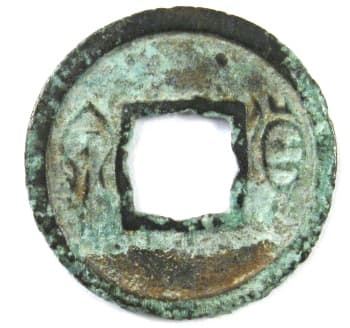
This coin is a huo quan (货泉) which translates as "wealth coin" or "money coin".
These coins were cast beginning in the year 14 AD by Wang Mang.
This huo quan is considered a very early example of a Chinese coin with a flower hole.
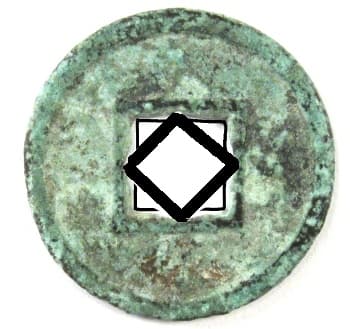
The flower hole may not be as obvious as that on the coins to follow so I have outlined the eight sides of the hole for your convenience.
The diameter of the coin is 28 mm and the weight is 2.1 grams.
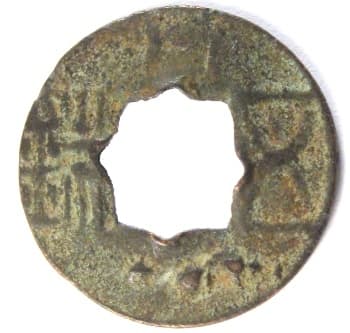 The coinage
of the Western
Han and Eastern
Han Dynasties was
dominated by the wu zhu (五 铢) coin.
The coinage
of the Western
Han and Eastern
Han Dynasties was
dominated by the wu zhu (五 铢) coin.
At the left is an example of an Eastern Han wu zhu coin.
This coin, however, is quite remarkable in that it displays a number of special characteristics.
The coin has a very nice flower hole.
Below the square hole are three "dots" which the Chinese refer to as "stars".
Above the square hole are two vertical lines which are believed to represent the number "two", and connecting these two lines is an incused line creating what some believe is the Chinese character gong (工).
The coin has a diameter of 23.5 mm and a weight of 2.2 grams.
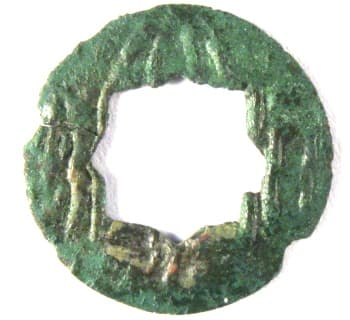 With the end
of the Han Dynasty, China
entered a period of disunity
and warfare known as the Three
Kingdoms.
With the end
of the Han Dynasty, China
entered a period of disunity
and warfare known as the Three
Kingdoms.
The Kingdom of Shu was one of these Three Kingdoms and the coin at the left was cast there during the years 221-265.
The inscription is tai ping bai qian (太 平百钱) which translates as Taiping (Great Peace) One Hundred Cash.
This is a small and thin specimen but one that exhibits a flower hole.
Another very distinctive variety of this coin, which reflects Daoist (Taoist) influences, can be seen at Chinese Coins with Charm Features.
This coin has a diameter of 19.5 mm and a weight of only 0.7 grams.
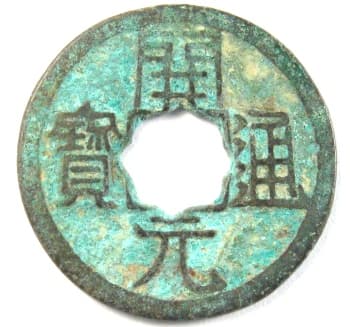 Beginning in the
4th year (621) of the Wu
De reign of Emperor
Gaozu, use of the wu
zhu (五
铢) coins was abolished
and a new coin began to be cast
with the inscription kai
yuan tong bao (开
元 通宝).
Beginning in the
4th year (621) of the Wu
De reign of Emperor
Gaozu, use of the wu
zhu (五
铢) coins was abolished
and a new coin began to be cast
with the inscription kai
yuan tong bao (开
元 通宝).
An example of a kai yuan tong bao with a well-formed flower hole is displayed here.
This new coin was a monumental change in the history of Chinese coinage because Chinese coins were now no longer named after their weight, such as "half tael" (ban liang 半两) or "five zhu" (wu zhu 五铢), but instead would have inscriptions such as tong bao(通 寶), yuan bao (元 寶) and zhong bao (重 寶).
Another important change was that the coin inscription would was no longer written in the ancient zhuan shu (篆书) or "seal" script but rather in li shu (隶书) or "official" script which is a square and plain style of Chinese calligraphy.
Emperor Gaozu had one of the Tang Dynasty's most famous calligraphers, Ouyang Xun (欧阳询), write the inscription for the new coin and these kai yuan tong bao cash coins would continue to be cast for more than 200 years.
The coin has a diameter of 25 mm and a weight of 3.1 grams.
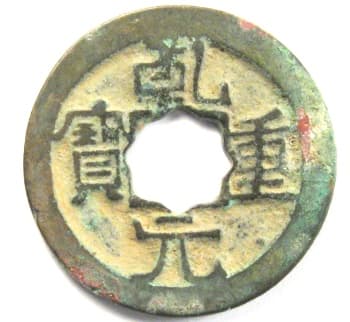
As mentioned in the history section above, coins with flower holes started to become more commonly seen during the Tang Dynasty.
This is an ordinary one cash coin with a nicely formed flower hole. The inscription reads qian yuan zhong bao (乾 元重宝) and these coins were cast during the years 759-762 of the reign of Emperor Su Zong (756-762).
The coin has a diameter of 23 mm and a weight of 3.5 grams.
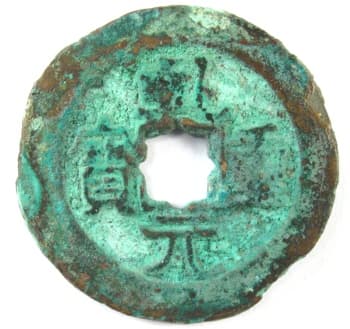
The Chinese coin at the left is also a qian yuan zhong bao (乾元重宝) cast beginning in the second year (759 AD) of the Qian Yuan reign of Emperor Su Zong (756-762).
This particular specimen also has a nicely centered eight-sided flower hole.
The flower or rosette hole is clearly seen on the reverse side of the coin as well.
Please note that this coin has a double outer rim. This dual rim (chonglun 重轮) was done intentionally to indicate that the coin was equal in value to 50 ordinary cash coins.
This coin has a diameter of 35 mm and a weight of 15 grams.
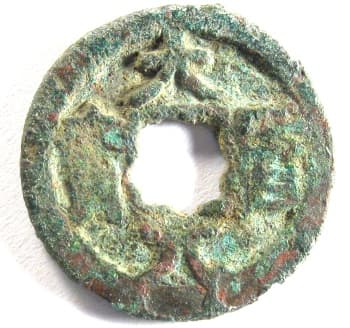
The inscription on this Tang Dynasty cash coin is read clockwise as da li yuan bao (大历元宝).
The coin has a well-formed flower hole and was cast during the Dali reign (766-779) of Emperor Dai Zong.
The diameter is 22.5 mm and the weight is 2.6 grams.
Other mints subsequently produced coins of this type with a character on the reverse side indicating the prefecture where the coin was cast. For this reason, these coins are commonly referred to as Hui Chang Kai Yuan (会昌开元) coins.
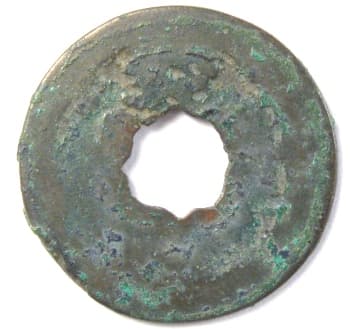
This is the reverse side of the coin.
If you observe closely, you will notice the Chinese character yan (兖) just above the flower hole.
This indicates that this Hui Chang Kai Yuan coin was cast at the mint located at Yan Prefecture in Shandong.
In general, the workmanship of Hui Chang kai yuan tong bao coins does not match that of the kai yuan tong bao coins cast at the beginning of the Tang Dynasty.
The diameter of this coin is 24 mm and the weight is 3.1 grams.
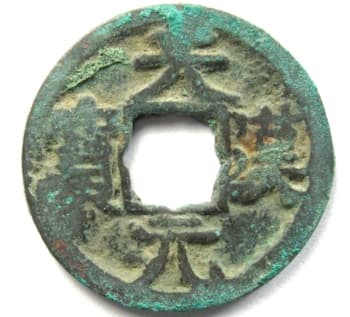
Following the Tang Dynasty, South China was ruled during the years 907-960 by the Five Dynasties and Ten Kingdoms.
This coin was cast in the year 917 which was the first year of the Tian Han reign of King Wang Jian (907-918) of the Former Shu (First Shu) Kingdom (907-925).
The inscription is read clockwise as tian han yuan bao (天汉元宝).
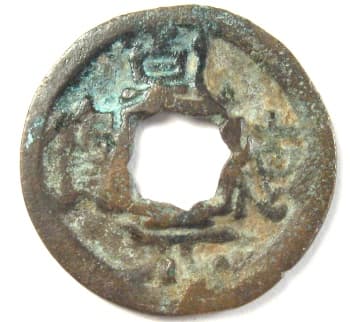
This coin, with a prominent flowerhole, was cast during the reign of Wang Yan (919-925), the son of Wang Jian, of the Former Shu Kingdom.
The inscription reads clockwise as qian de yuan bao (乾德元宝).
These coins were cast during the years 919-924.
The diameter is 23.8 mm and the weight is 3.1 grams.
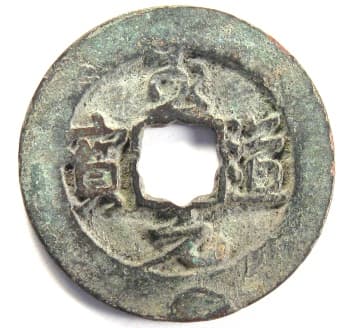
This is one of the earliest examples of a Northern Song Dynasty coin with a flower hole.
The inscription is written in running script and is read clockwise as zhi dao yuan bao (至道元宝).
The coin was cast during the years 995-997 of the reign of Emperor Tai Zong (976-997).
The diameter is 25 mm and the weight is 3.5 grams.
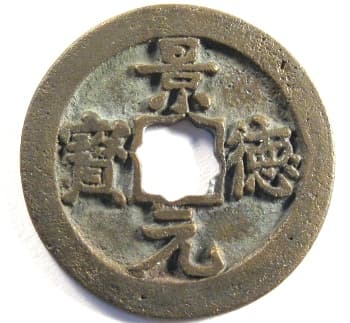
Northern Song cash coins tend to be finely cast as illustrated by this coin with its deep characters.
The inscription reads clockwise, beginning at the top, as jing de yuan bao (景德元宝) and is written in regular script.
This coin with a flower hole was cast during the years 1004-1007 of the reign of Emperor Zhen Zong (998-1022).
The diameter is 25.9 mm and the weight is 3.7 grams.
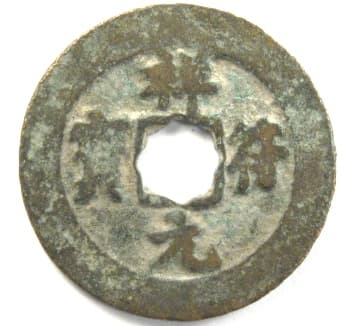
This coin with a flower hole was cast during the years 1008-1016 of the reign of Emperor Zhen Zong (998-1022) of the Northern Song.
The inscription is read clockwise as xiang fu yuan bao (样符元宝) and is written in regular script.
The diameter is 25 mm and the weight is 3.5 grams.
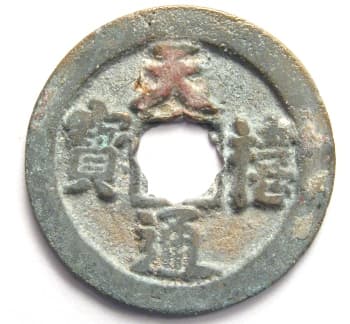
This Northern Song coin with a flower hole was cast during the years 1017-1022 in the reign of Emperor Zhen Zong (998-1022).
The inscription is read clockwise, starting with the top character, as tian xi tong bao (天禧通宝) and is written in regular script.
The coin is 25 mm in diameter and weighs 3.5 grams.
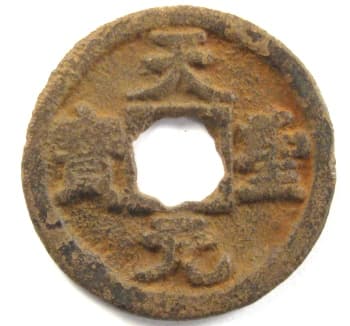
The inscription on this Northern Song coin is read clockwise as tian sheng yuan bao (天圣元宝) and is written in regular script.
This coin with a flower hole was minted during the years 1023-1031 of the reign of Emperor Ren Zong (1022-1063).
The diameter is 24.5 mm and the weight is 2.6 grams.
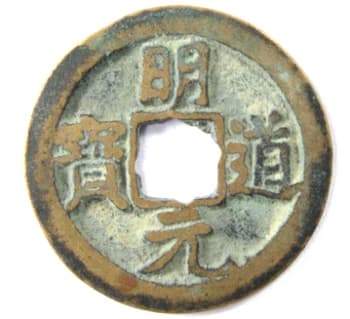
This particular Northern Song dynasty coin was only cast in the years 1032-1033 during the reign of Emperor Ren Zong (1022-1063).
The inscription is written in regular script and is read clockwise, beginning at the top, as ming dao yuan bao (明道元宝).
This specimen has a flower (rosette) hole.
The coin has a diameter of 26 mm and weighs 4.2 grams.
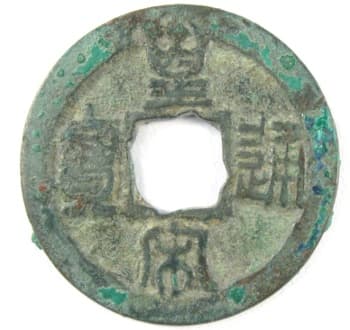
During the years 1039-1054 of Emperor Ren Zong's reign, coins with the inscription huang song tong bao (皇宋通宝) were cast.
In this example, the inscription is read top to bottom and right to left.
The inscription is written in seal script and the coin has a flower hole.
The diameter is 25 mm and the weight is 3.5 grams.
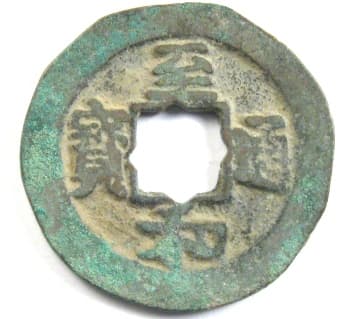
This coin from Emperor Ren Zong was cast during 1054-1055.
The inscription is zhi he tong bao (至 和通宝) and is written in regular script.
The coin displays a very nice flower or rosette hole.
The diameter is 25 mm and the weight is 3.6 grams.
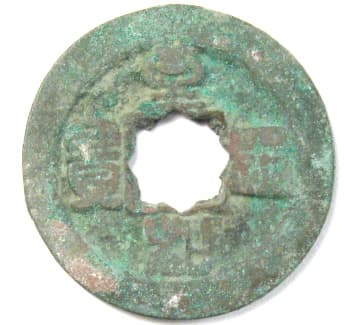
The inscription (legend) on this cash coin is also zhi he tong bao (至和通宝) but it is written in seal script.
This coin was also cast during the years 1054-1055 of the reign of Song Dynasty Emperor Ren Zong.
The coin has a diameter of 25 mm and a weight of 3.4 grams.
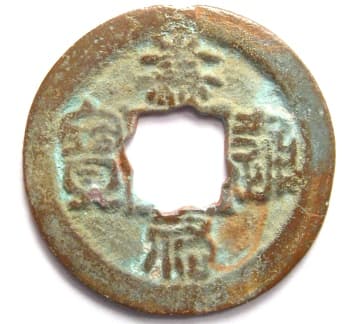
This coin was also cast during the reign of Emperor Ren Zong.
The inscription (legend), written in seal script, is jia you tong bao (嘉祐通寳) and the coin was cast in the years 1056-1063.
The diameter is 24.8 mm and the weight is 3.3 grams.
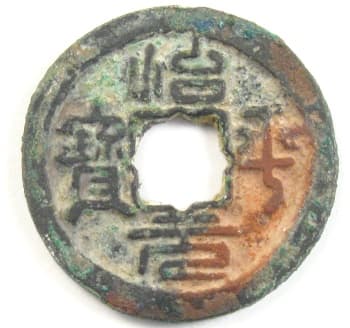
Emperor Ying Zong reigned during the years 1064-1067.
This coin has the inscription (legend) zhi ping yuan bao (治平元宝) written in a beautiful seal script.
It was cast during the entire period of Emperor Ying Zong's rule.
The coin has a diameter of 24 mm and a weight of 3.5 grams.
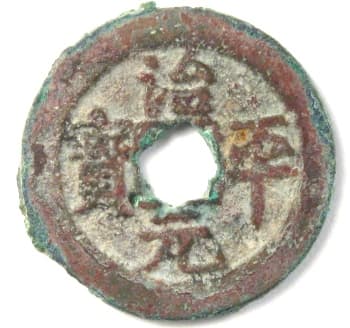
This cash coin was also cast during the years 1064-1067 of Emperor Ying Zong's reign.
The coin has the same zhi ping yuan bao (治平元宝) inscription but, in this case, is written in regular script.
The diameter is 24 mm and the weight is 4 grams.
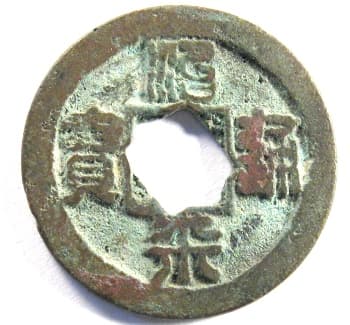
This is another cash coin cast during the Zhi Ping reign of Emperor Ying Zong.
In this case, however, the inscription is zhi ping tong bao (治平通宝) written in seal script.
These coins were cast in the years 1064-1067.
The coin is distinctive in that the character (ping 平), located below the square hole, is written with three strokes at the bottom instead of one.
The diameter is 24.7 mm and the weight is 4.1 grams.
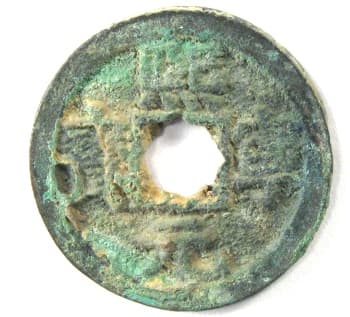
The reign of Emperor Shen Zong (1068-1085) of the Northern Song included the casting of coinage with the inscription xi ning yuan bao (熙宁元宝) during the years 1068-1077.
This is a variety of such a coin which happens to have a flower hole.
The inscription is written in regular script and is read clockwise.
The coin has a diameter of 24.5 mm.
The coin is thicker than most Song dynasty coins of this size which explains its weight of 5.5 grams.
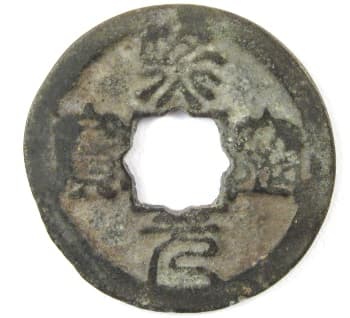
At the left is another "flower hole" coin with the same xi ning tong bao (熙 宁元宝) inscription.
This inscription, however, is written in seal script.
Coins with this style of calligraphy were cast during the years 1068-1077 of the reign of Emperor Shen Zong.
The diameter is 24.5 mm and the weight is 3.8 grams.
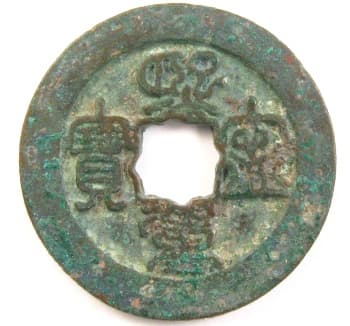 Beginning in the
year 1071, larger denomination
coins, initially valued at 10 cash
coins each, were produced.
These coins were issued during the
reign of Emperor Shen Zong to pay
for military expenses.
Beginning in the
year 1071, larger denomination
coins, initially valued at 10 cash
coins each, were produced.
These coins were issued during the
reign of Emperor Shen Zong to pay
for military expenses.
The coin at the left is one of these larger cash coins with this particular specimen displaying a flower (rosette) hole.
The inscription reads xi ning zhong bao (熙宁重宝) and is written in seal script.
These coins were gradually devalued to be equal to 3 cash coins and finally to 2 cash coins.
Casting of xi ning zhong bao coins ceased in 1077.
The diameter of this coin is 29 mm and the weight is 8 grams.
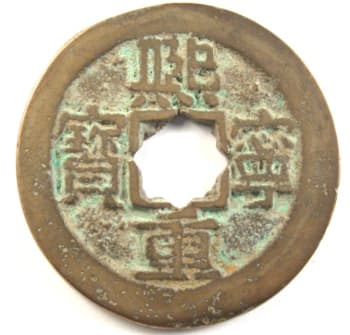
Similar to the above large cash coin, this is another xi ning zhong bao (熙宁重宝) but one which is written in regular script.
This coin was also cast during the years 1071-1077 of the reign of Emperor Shen Zong.
The coin has a diameter of 32 mm and a weight of 8.4 grams.
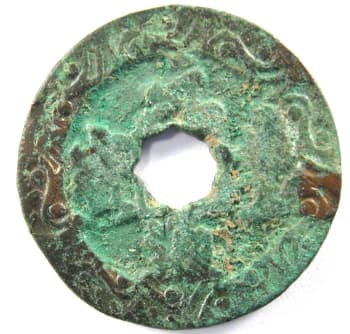 The coin to the
left is from the Northern Song
Dynasty and is quite
unusual. It has a very
prominent flower hole but it also
has a very distinctive design on
its rim or border.
The coin to the
left is from the Northern Song
Dynasty and is quite
unusual. It has a very
prominent flower hole but it also
has a very distinctive design on
its rim or border.
The inscription is written in "running" script and is read clockwise, starting at the top, as yuan feng tong bao (元丰通宝). It was cast during the period 1078-1085 of the reign of Emperor Shen Zong (1068-1085).
The government sometimes cast coins with distinctive borders but most such designs are usually seen only on charms or amulets.
The rim design with its S-shaped curves and dots reminds one of the yinyang (阴 阳) or taiji (太 极) symbol representing the basic polarities of the universe of light/dark, male/female, etc.
The design can also be interpreted as stylized dragons chasing pearls. (For more information please visit Hidden Meaning of Chinese Charm Symbols.)
This coin has a diameter of 30 mm and a weight of 7.3 grams.
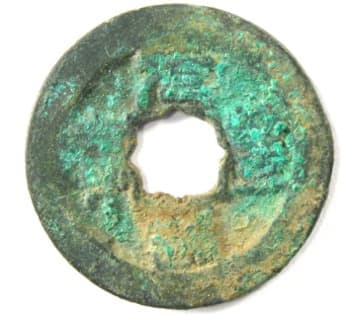 As is the case with
most Song dynasty coins, there are
different calligraphic styles for
each period title inscription.
As is the case with
most Song dynasty coins, there are
different calligraphic styles for
each period title inscription.
The yuan feng tong bao (元丰通宝) coin shown above, with the engraved border, is written in running script while the coin to the left has the very same inscription but is written in seal script.
This coin was cast during the same time period (1078-1085) of Emperor Shen Zong's reign.
Song dynasty coins with flower (rosette) holes can be found in all calligraphic styles of writing including seal, Li, regular, running and grass styles.
The diameter of this coin is 25 mm and the weight is 3.6 grams.
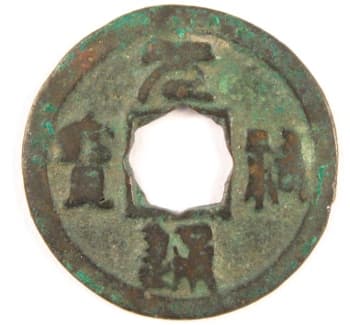
Emperor Zhe Zong ruled the Northern Song during the period 1086-1100.
The seal script inscription on this coin is read clockwise as yuan you tong bao (元祐通寳).
This flower hole coin was cast during the years 1086-1093 AD.
The diameter is 24 mm and the weight is 3.2 grams.
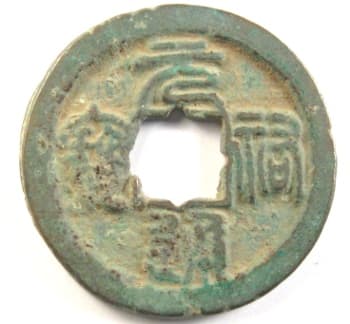
This is another yuan you tong bao (元祐通寳) coin written in seal script.
It was cast during the same years (1086-1100) of the reign of Emperor Zhe Zong as the above coin.
This specimen, however, is a "large" coin and had the equivalent value of several small cash coins when issued.
The diameter is 30.5 mm and the weight is 8.5 grams.
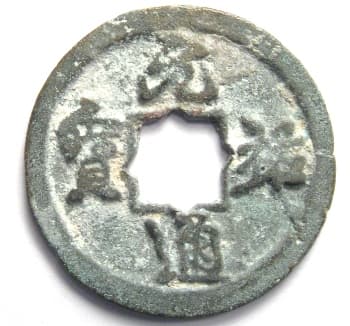
This is also a yuan you tong bao (元祐通寳) Song Dynasty coin cast in the years 1086-1093 AD during the reign of Emperor Zhe Zong.
The inscription here, however, is written in running style.
This coin has a diameter of 25 mm and a weight of 3.5 grams.
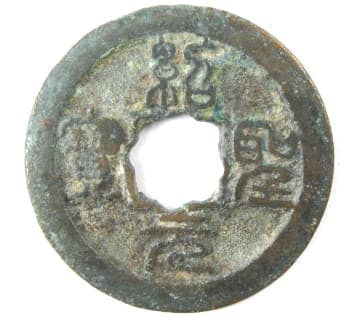
This coin is also from the reign of Emperor Zhe Zong.
From 1094-1097 coins with the inscription shao sheng yuan bao (绍圣元宝) were cast.
This flower hole coin is written in seal script and the inscription, in this case, is read clockwise.
The diameter is 24 mm and the weight is 4 grams.
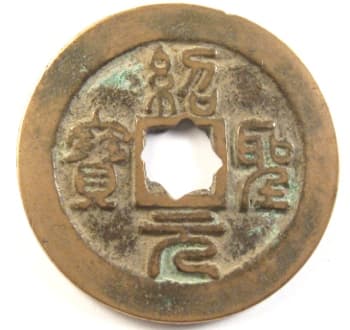
The coin at the left appears to be almost identical to the one above.
The inscription is the same shao sheng yuan bao (绍圣元宝) written in seal script and the coin was cast during the same years (1094-1097) of the reign of Emperor Zhe Zong.
The difference, however, is that this is a "large" cash coin. These larger cash coins were equal in value to several, sometimes even equal to 10, of the smaller cash coins.
This large cash coin has a diameter of 31 mm and a weight of 7.3 grams.
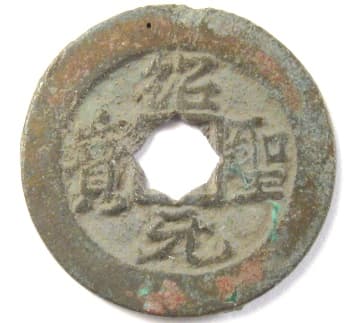
The coin at the left is also a shao sheng yuan bao (绍圣元宝) cast in the years 1094-1097 of the reign of Emperor Zhe Zong.
The inscription on this specimen, however, is written in running script.
The diameter of the coin is 24.5 mm and the weight is 3.6 grams.
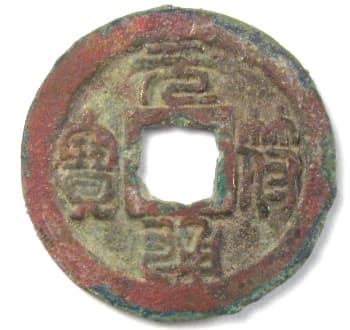
This very attractive coin was also cast during the reign of Emperor Zhe Zong.
The inscription, written in seal script, is read clockwise as yuan fu tong bao (元符通宝).
This coin was cast during the years 1098-1100.
The diameter is 25 mm and the weight is 3 grams.
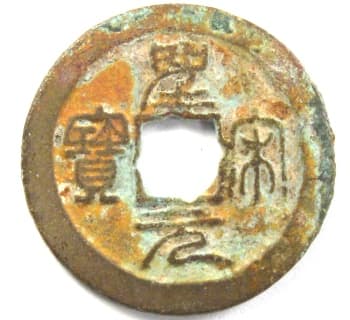
The coin at the left was cast during the years 1101-1106 of the reign of Emperor Hui Zong (1101-1125).
The inscription is written in seal script and is read clockwise as sheng song yuan bao (圣宋元宝).
This coin with a flower hole has a diameter of 24.5 mm and a weight of 3 grams.
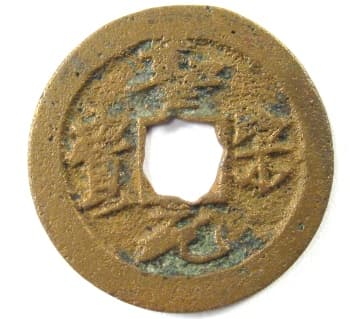
During the years 1101-1106 of Emperor Hui Zong's reign, coins with the inscription sheng song yuan bao (圣宋元宝) were cast.
This is an example of such a coin with a flower hole.
It is written in running script and the inscription is read clockwise beginning at the top.
The coin is 24.5 mm in diameter and weighs 3.5 grams.
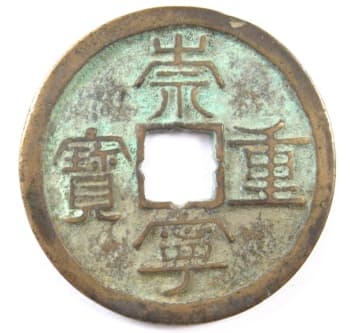 This is another
example of a Northern Song Dynasty
coin with a flower (rosette) or
"star" center hole. The coin
is a chong ning zhong bao
(崇宁重宝) cast in the years 1102-1106
during the reign of Emperor Hui
Zong (1101-1125).
This is another
example of a Northern Song Dynasty
coin with a flower (rosette) or
"star" center hole. The coin
is a chong ning zhong bao
(崇宁重宝) cast in the years 1102-1106
during the reign of Emperor Hui
Zong (1101-1125).
This is a "10 cash" coin which means its value was equivalent to ten cash coins.
The traditional square hole is outlined by the inner border. Exactly in the middle of each of the four sides of the hole can be seen what would be the four corners of another "square".
Please note that the inscription and the face of the coin show no signs of mold shifting during the casting and that there is no extra metal in the hole.
The creation of the flower hole could only have been done manually and intentionally.
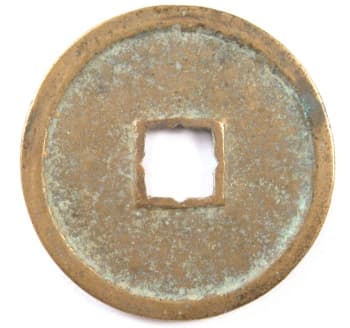
The reverse side of the coin also clearly shows the same four corner points exactly in the middle of each side of the square hole which would delineate the second square.
This well cast coin is 35 mm in diameter and weighs 9.48 grams.
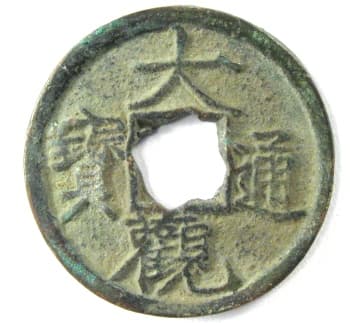
This Northern Song coin displays Emperor Hui Zong's personal calligraphy known as Slender Gold script.
The inscription is da guan tong bao (大观通宝) and is written top to bottom and right to left.
These coins were cast during the years 1107-1110 and this particular specimen has a flower hole.
The coin has a diameter of 25 mm and a weight of 3.8 grams.
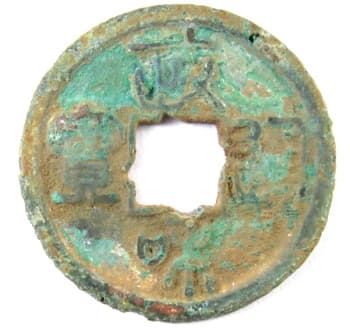
This coin was also cast during the reign of Emperor Hui Zong but in the years 1111-1117 AD.
The inscription is written in "seal" script and reads zheng he tong bao (政和通宝).
The diameter is 25 mm and the weight is 3.1 grams.
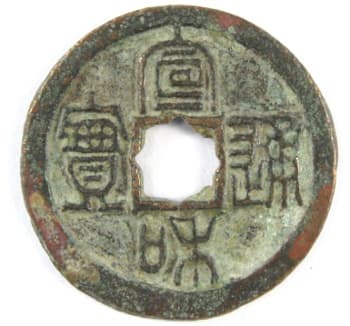
At the left is a coin with a flower hole issued near the end of Emperor Hui Zong's reign.
The inscription is written in a very beautiful seal script and reads xuan he tong bao (宣和通宝).
The coin was cast during the years 1119-1125 AD.
This coin has a diameter of 24.5 mm and a weight of 3.6 grams.
Southern Song Dynasty
Coins (1127 - 1279 AD)
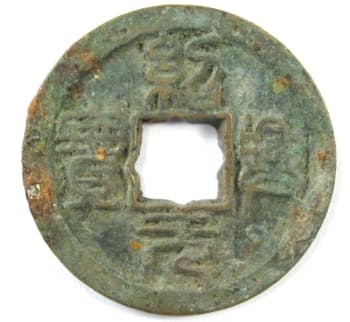
This Chinese coin was cast during the years 1131-1162 AD of the reign of Emperor Gao Zong (1127-1162 AD) of the Southern Song Dynasty.
The flower hole is clearly seen.
The calligraphy is seal script and the inscription is read clockwise beginning at the top as shao xing yuan bao (绍兴元宝).
This coin is larger than an average sized cash coin. This is because it is a "2 cash" coin meaning it was worth two normal cash coins.
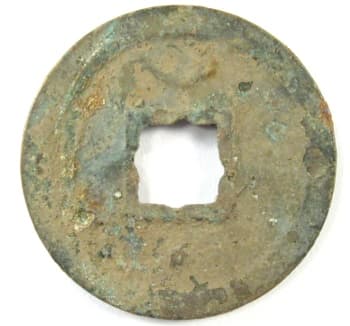
The reverse side also displays the eight corners or points of the flower hole.
If you look closely, you will see a crescent moon above the square hole and a star below the hole.
This coin has a diameter of about 29.2 mm and weight of 7.6 grams.
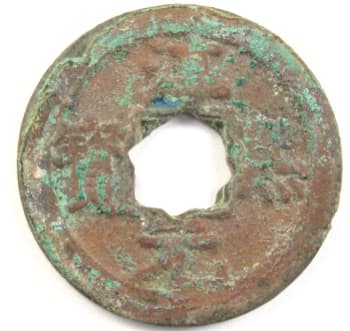
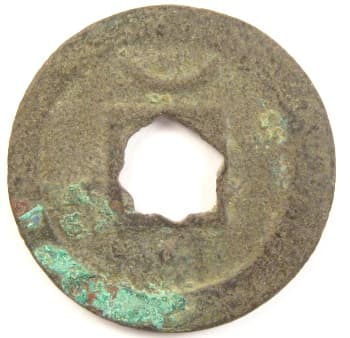
Emperor Xiao Zong (1163-1190) issued this large cash coin during the years 1174-1189.
The inscription is written in regular script and reads chun xi yuan bao (淳熙元宝).
As is the case with the shao xing yuan bao (绍兴元宝) coin above, the reverse side of this chun xi yuan bao also has a crescent moon above the flower hole and a dot (star) below.
The diameter is 30 mm and the weight is 6.7 grams.
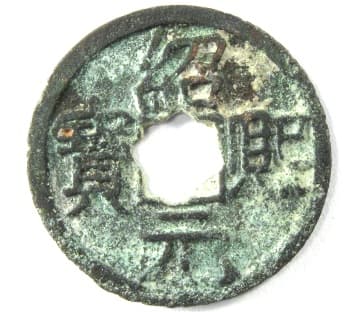
This Southern Song coin was cast during the short reign of Emperor Guang Zong (1190-1194).
The inscription (legend) is written in regular script and is read clockwise as shao xi yuan bao (绍熙元宝).
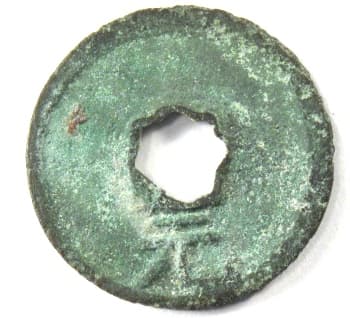
The reverse side of the coin has the character yuan (元) below the flower hole which means "first".
"First" means the first year of cash coin production using Emperor Guang Zong's period title "shao xi" (绍熙).
This coin was thus cast in the year 1190.
The coin has a diameter of 24.5 mm and a weight of 3.4 grams.
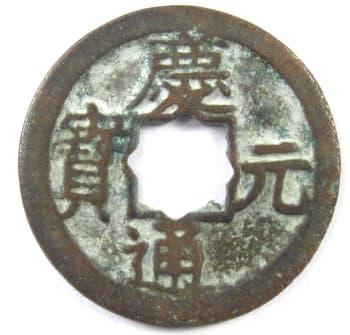
The coin with the flower hole at the left is a qing yuan tong bao (庆元通宝) cast in the years 1195 - 1200 during the reign of Emperor Ning Zong (1195 - 1224) of the Southern Song.
The flower or rosette hole is very prominent.
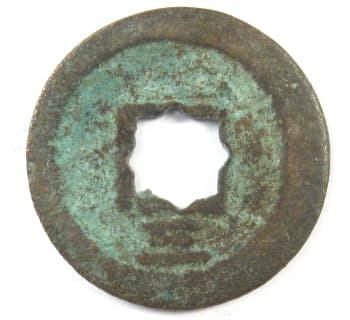
Below the hole on the reverse side is the Chinese character for the number "three" (san 三). This indicates that the coin was cast in the third year (1197) of the Qing Yuan reign.
The coin has a diameter of 25 mm and a weight of 3.8 grams.
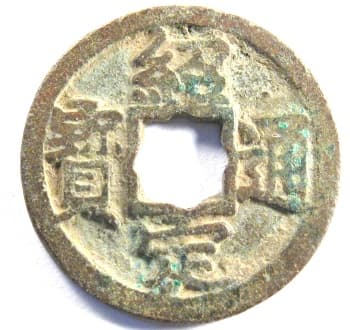
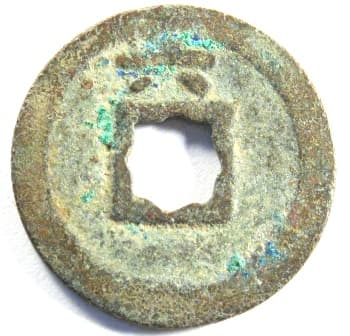 This cash
coin is from the Shao Ding
reign of Emperor
Li Zong (1225-1264).
This cash
coin is from the Shao Ding
reign of Emperor
Li Zong (1225-1264).
The inscription reads shao ding tong bao (绍定通宝).
The Chinese character for "6" (liu 六) on the reverse side indicates that this particular coin was cast in the 6th year of the Shao Ding reign which would be the year 1233.
The coin has a diameter of 24.3 mm and a weight of 3.7 grams.
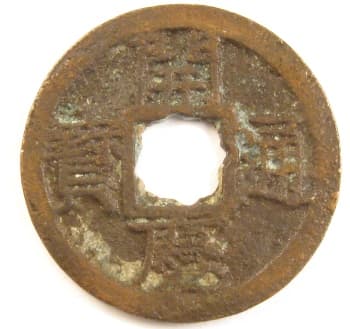
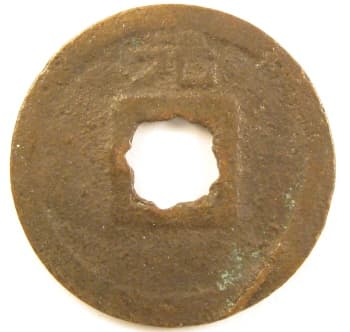 This cash coin
was also cast during the reign
of Emperor Li Zong
(1225-1264).
This cash coin
was also cast during the reign
of Emperor Li Zong
(1225-1264).
The inscription is kai qing tong bao (开庆通宝).
The reverse side of this 1 cash coin has the Chinese character yuan (元), meaning "first", above the flower hole.
The yuan means that the coin was cast in the first year (1259) of the Kai Qing reign. In actuality, Emperor Li Zong only used this reign title for one year so kai qing tong bao coins were only cast in the year 1259.
The diameter is 25 mm and weight is 3.5 grams.
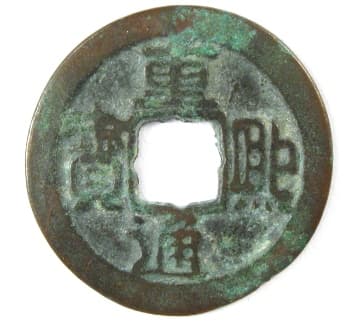 The Liao Dynasty was ruled by a
nomadic people known as
the Qidan
(契丹) and occupied an area
that included Manchuria, a
portion of Mongolia and
parts of Hebei and Shanxi
provinces.
The Liao Dynasty was ruled by a
nomadic people known as
the Qidan
(契丹) and occupied an area
that included Manchuria, a
portion of Mongolia and
parts of Hebei and Shanxi
provinces.
The inscription (legend) on this Liao Dynasty coin is read clockwise, beginning at the top, as chong xi tong bao (重熙通宝). It was cast during the years 1032-1055 by Emperor Xing Zong (兴宗 1031-1055).
The Liao patterned their coinage on that of the Northern Song although their craftmanship was not of the same level.
The flower hole on this particular coin is very clear. There is a notch in the center of each side of the center hole indicating the four corners of a second square hole.
There are several recognized varieties of the chong xi tong bao. Some coins have the tong (通) written in "official" or "clerky" style (li shu 隶书). Other coins have the tong (通) written in "regular" or "orthodox" script (kai shu 楷书).
There is a "large character" (da zi 大字) variety which can have the tong (通) in either "official" or "orthodox" script.
There are also varieties where the xi (熙) character is written slightly differently.
Some coins have a "moon" or "crescent" (仰月) above the square hole on the reverse side while other coins have a "star" (星) beneath the hole. These varieties are fairly rare.
The chong xi tong bao coin displayed here is the more common "regular" tong (通) variety. The "official" tong (通) variety is scarcer.
This coin has a diameter of 24 mm and a weight of 2.7 grams.
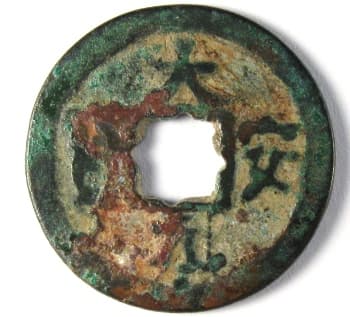 This
coin with a flower hole
was cast during the reign
of Emperor
Dao
Zong (道宗 1055-1101)
of the Liao Dynasty.
This
coin with a flower hole
was cast during the reign
of Emperor
Dao
Zong (道宗 1055-1101)
of the Liao Dynasty.
The inscription reads clockwise as da an yuan bao (大安元宝).
The coin was cast during the years 1085-1093.
This is the "small an" or "short an" (duan an 短安) variety of the coin. The yuan (元) character on some "small an" coins has a "right shoulder" (右挑元) which is particularly rare.
There is also a "long an" (chang an 长安) variety in which the an character is bigger. "Long an" coins with a "two shoulder yuan" (双挑元) character are also very rare.
Some coins have a "moon" (月) or "star" (星) on the reverse side but they are fairly scarce.
The diameter of the displayed da an yuan bao is 24.3 mm and the weight is 3.2 grams.
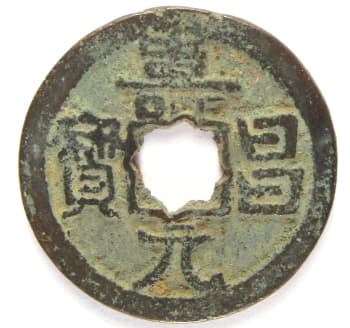
This Liao Dynasty coin was cast in the years 1095-1101 during the reign of Emperor Dao Zong (道 宗 1055-1101).
The inscription is read clockwise as shou chang yuan bao (寿昌元宝).
There exist "long chang" (chang chang 长昌) and "short chang" (duan chang 短昌) varieties of this coin. The second horizontal stroke of the yuan (元) can have a right shoulder (you tiao 右挑), left shoulder (zuo tiao 左挑) or two shoulders (shuang tiao 双挑).
The diameter of this coin is 23.8 mm and the weight is 3.7 grams.
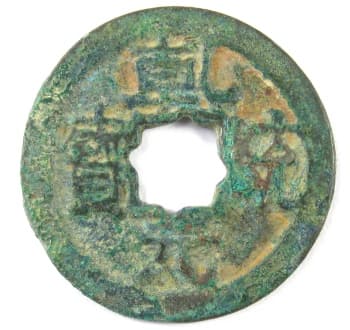
This coin was cast during the years 1101-1110 by Emperor Tian Zuo (天祚 1101-1125) of the Liao Dynasty.
The inscription, read in the same manner as the coin above, is qian tong yuan bao (乾统元宝).
This coin also has a prominent and well-shaped flower hole.
Some coins, such as this one, have a yuan (元) character with a left shoulder (zuo tiao 左挑). Other coins may have the yuan with a right shoulder (you tiao 右挑) or both shoulders (shuang tiao 双挑).
There are also varieties where the 日 in the qian (乾) character is written differently.
These coins can sometimes have a "star" (xing 星) on the reverse side.
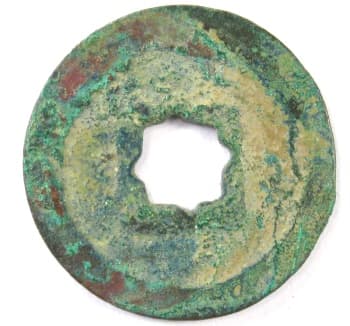
The eight side flower hole is also clearly seen on the reverse side of the coin.
The diameter of this coin is slightly greater than 24 mm and its weight is 3.4 grams.
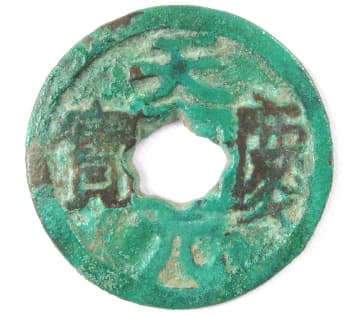
This Liao Dynasty coin is also from the reign of Emperor Tian Zuo (天祚帝) but was cast during the years 1111-1120.
The inscription is read in a clockwise manner as tian qing yuan bao (天庆元宝).
The flower (rosette) hole on this coin is also very distinctive.
Varieties of this coin include the yuan (元) character with left shoulder (zuo tiao 左挑), right shoulder (you tiao 右挑) and both shoulders (shuang tiao 双挑).
There is also a rare variety which has a "star" (xing 星) beneath the qing (庆).
This coin has a diameter of 24 mm and a weight of 3.4 grams.
Jin Dynasty Coins
(1115-1234 AD)
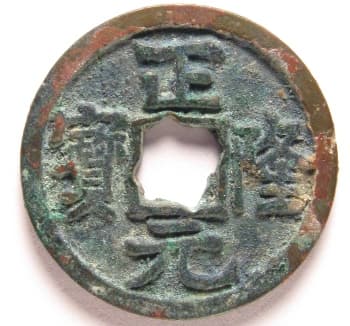
During the late Northern Song Dynasty, the Nuzhen (Jurchen, Jurched) (女真) nationality conquered most of northern China and established the Jin Dynasty.
At first, they continued the use of coins from the Song and Liao dynasties.
Beginning in 1154, however, they began to issue paper money known as jiao chao (交钞).
And, in the second year of Zheng Long (1157) they began to mint the bronze coins zheng long yuan bao (正隆元宝).
A few zheng long yuan bao coins were produced with a flower hole as shown here.
The coin has a diameter of 25 mm and a weight of 4.3 grams.
Ming Dynasty
Coins (1368 - 1644 AD)
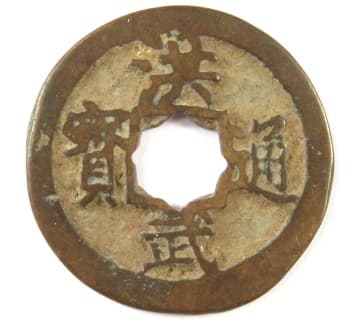
Chinese coins with flower holes declined in numbers fairly rapidly after the Song Dynasty but could still be seen even as late as the Ming Dynasty.
This Ming Dynasty coin is a hong wu tong bao (洪武通宝) which was cast during the Hong Wu reign of Emperor Tai Zu (1368-1398).
The coin has a very clean and well centered flower hole.
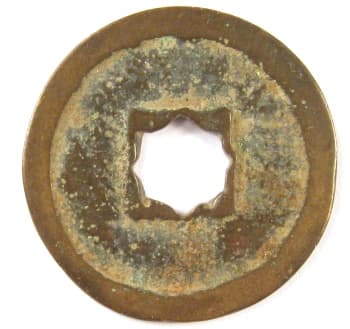
The flower (rosette) hole is also very evident on the reverse side of the coin.
This Ming Dynasty coin is slightly greater than 23 mm in diameter and weighs 3.9 grams.
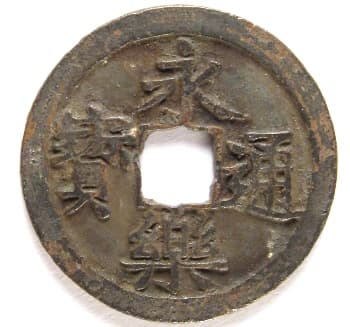
This is a slightly later Ming Dynasty cash coin displaying a flower (rosette) hole.
The inscription reads yong le tong bao (永乐通宝) and the coin was cast during the reign of Emperor Cheng Zu (1403-1424).
This coin was recovered from a Ming Dynasty shipwreck in the South China Sea.
The diameter is 25.5 mm and the weight is 3.4 grams.
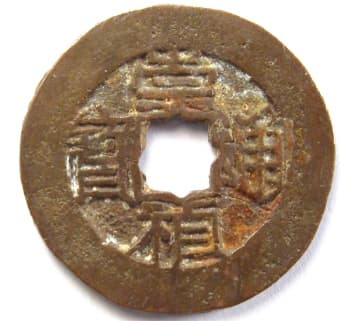
This coin was cast during the reign of Emperor Si Zong (1628-1644) of the Ming Dynasty.
The inscription reads chong zhen tong bao (崇 祯通宝).
This Ming dynasty coin is probably one of the last of the Chinese cash coins to have a flower hole.
The diameter is 23.5 mm and the weight is 2.5 grams.
Return to Ancient Chinese Charms and Coins
One theory is that they may have identified a location where the coins were cast. Perhaps they signified a year or time of year when a coin was cast.
Ancient coins sometimes included stars, moons, and other symbols which are not well understood (please see Emergence of Chinese Charms, Chinese Coins with Charm Features and Charm Symbols: Star, Moon, Cloud and Dragon). The flower hole may have served a similar symbolic function.
It is also noteworthy that the production of this type of coin decreased drastically following the end of Song "matched coins" and the requirement mentioned above that coins beginning in the year 1180 would have a number on the reverse indicating the year they were cast. If the flowered hole was serving a similar function up to this time, it may no longer have been needed after these changes.
Besides their esthetic quality, holes with eight or six sides have a special meaning to the Chinese. The Chinese word for "eight" (ba 八) has a similar pronunciation to the word to "prosper" or "wealth" (fa cai 发财). The Chinese word for "six" (liu 六) is also considered auspicious because its pronunciation is similar to the word "prosperity" (lu 禄).
Also, the Chinese themselves refer to these as "chestnut" (lizi 栗子) holes. "Chestnut" has the same pronunciation as "establishing sons" (li zi 立子) and thus expresses the hope for having a large family.
Other Asian countries, including Korea, Japan and Annam (Vietnam), adopted the Chinese cash coin as the model for their own coinage. The quality of these coins could vary drastically. If flower holes were the result of poor quality casting then one would expect to see flower hole coins produced in these countries as well. Yet, it is interesting to note that very, very few coins from these other countries have flower holes. This further strengthens the argument that the appearance of flower holes on Chinese cash coins must have been intentional.
Even though they are rare, flower hole coins from these other Asian countries can sometimes be found. As an example, a sang pyong tong bo (Chinese: chang ping tong bao 常平通宝) coin with a flower hole that was cast in Korea by the Government Office of Pukhan Mountain Fortress in 1830 may be seen at Korean Coins.
Chinese Coins with Flower Holes
Western
Han Dynasty Coins (206 BC - 25
AD)
The inscription on this coin is read right to left as ban liang (半 两).
This coin was cast during the years 186-182 BC during the reign of Empress Lu of the Western Han Dynasty and is known as a 8 zhu (铢) ban liang.
The coin has a very nice flower hole.
Flower holes on coins from the early Han Dynasty are very scarce. In fact, this particular coin is the earliest example of a Chinese coin with a flower hole that I have seen.
The diameter of the coin is 32 mm and the weight is 3.8 grams.
Wang
Mang Coins (7 - 23 AD)

This coin is a huo quan (货泉) which translates as "wealth coin" or "money coin".
These coins were cast beginning in the year 14 AD by Wang Mang.
This huo quan is considered a very early example of a Chinese coin with a flower hole.

The flower hole may not be as obvious as that on the coins to follow so I have outlined the eight sides of the hole for your convenience.
The diameter of the coin is 28 mm and the weight is 2.1 grams.
Eastern Han Dynasty Coins (25-220 AD)
 The coinage
of the Western
Han and Eastern
Han Dynasties was
dominated by the wu zhu (五 铢) coin.
The coinage
of the Western
Han and Eastern
Han Dynasties was
dominated by the wu zhu (五 铢) coin.At the left is an example of an Eastern Han wu zhu coin.
This coin, however, is quite remarkable in that it displays a number of special characteristics.
The coin has a very nice flower hole.
Below the square hole are three "dots" which the Chinese refer to as "stars".
Above the square hole are two vertical lines which are believed to represent the number "two", and connecting these two lines is an incused line creating what some believe is the Chinese character gong (工).
The coin has a diameter of 23.5 mm and a weight of 2.2 grams.
The Three Kingdoms Coins (220-280 AD)
 With the end
of the Han Dynasty, China
entered a period of disunity
and warfare known as the Three
Kingdoms.
With the end
of the Han Dynasty, China
entered a period of disunity
and warfare known as the Three
Kingdoms.The Kingdom of Shu was one of these Three Kingdoms and the coin at the left was cast there during the years 221-265.
The inscription is tai ping bai qian (太 平百钱) which translates as Taiping (Great Peace) One Hundred Cash.
This is a small and thin specimen but one that exhibits a flower hole.
Another very distinctive variety of this coin, which reflects Daoist (Taoist) influences, can be seen at Chinese Coins with Charm Features.
This coin has a diameter of 19.5 mm and a weight of only 0.7 grams.
Tang Dynasty Coins (618 - 907 AD)
 Beginning in the
4th year (621) of the Wu
De reign of Emperor
Gaozu, use of the wu
zhu (五
铢) coins was abolished
and a new coin began to be cast
with the inscription kai
yuan tong bao (开
元 通宝).
Beginning in the
4th year (621) of the Wu
De reign of Emperor
Gaozu, use of the wu
zhu (五
铢) coins was abolished
and a new coin began to be cast
with the inscription kai
yuan tong bao (开
元 通宝).An example of a kai yuan tong bao with a well-formed flower hole is displayed here.
This new coin was a monumental change in the history of Chinese coinage because Chinese coins were now no longer named after their weight, such as "half tael" (ban liang 半两) or "five zhu" (wu zhu 五铢), but instead would have inscriptions such as tong bao(通 寶), yuan bao (元 寶) and zhong bao (重 寶).
Another important change was that the coin inscription would was no longer written in the ancient zhuan shu (篆书) or "seal" script but rather in li shu (隶书) or "official" script which is a square and plain style of Chinese calligraphy.
Emperor Gaozu had one of the Tang Dynasty's most famous calligraphers, Ouyang Xun (欧阳询), write the inscription for the new coin and these kai yuan tong bao cash coins would continue to be cast for more than 200 years.
The coin has a diameter of 25 mm and a weight of 3.1 grams.

As mentioned in the history section above, coins with flower holes started to become more commonly seen during the Tang Dynasty.
This is an ordinary one cash coin with a nicely formed flower hole. The inscription reads qian yuan zhong bao (乾 元重宝) and these coins were cast during the years 759-762 of the reign of Emperor Su Zong (756-762).
The coin has a diameter of 23 mm and a weight of 3.5 grams.

The Chinese coin at the left is also a qian yuan zhong bao (乾元重宝) cast beginning in the second year (759 AD) of the Qian Yuan reign of Emperor Su Zong (756-762).
This particular specimen also has a nicely centered eight-sided flower hole.
The flower or rosette hole is clearly seen on the reverse side of the coin as well.
Please note that this coin has a double outer rim. This dual rim (chonglun 重轮) was done intentionally to indicate that the coin was equal in value to 50 ordinary cash coins.
This coin has a diameter of 35 mm and a weight of 15 grams.

The inscription on this Tang Dynasty cash coin is read clockwise as da li yuan bao (大历元宝).
The coin has a well-formed flower hole and was cast during the Dali reign (766-779) of Emperor Dai Zong.
The diameter is 22.5 mm and the weight is 2.6 grams.
Beginning
in the 5th year (845)
of the Hui Chang reign
of Emperor Wu Zong (841-846), cash
coins were cast with the
inscription kai
yuan tong bao (开元通宝).
However, these kai yuan tong bao coins differed from those cast at the beginning of the Tang Dynasty in that the reverse side displays a Chinese character.
The first coin of this type was cast under the authority of Li Shen, the Resident Administrator of Yangzhou Prefecture, and had the character chang (昌) on the reverse side to indicate the reign year Hui Chang.
However, these kai yuan tong bao coins differed from those cast at the beginning of the Tang Dynasty in that the reverse side displays a Chinese character.
The first coin of this type was cast under the authority of Li Shen, the Resident Administrator of Yangzhou Prefecture, and had the character chang (昌) on the reverse side to indicate the reign year Hui Chang.
Other mints subsequently produced coins of this type with a character on the reverse side indicating the prefecture where the coin was cast. For this reason, these coins are commonly referred to as Hui Chang Kai Yuan (会昌开元) coins.

This is the reverse side of the coin.
If you observe closely, you will notice the Chinese character yan (兖) just above the flower hole.
This indicates that this Hui Chang Kai Yuan coin was cast at the mint located at Yan Prefecture in Shandong.
In general, the workmanship of Hui Chang kai yuan tong bao coins does not match that of the kai yuan tong bao coins cast at the beginning of the Tang Dynasty.
The diameter of this coin is 24 mm and the weight is 3.1 grams.
Five Dynasties and Ten Kingdoms Coins (907-960)

Following the Tang Dynasty, South China was ruled during the years 907-960 by the Five Dynasties and Ten Kingdoms.
This coin was cast in the year 917 which was the first year of the Tian Han reign of King Wang Jian (907-918) of the Former Shu (First Shu) Kingdom (907-925).
The inscription is read clockwise as tian han yuan bao (天汉元宝).
This
particular specimen exhibits a
flower (rosette) hole.
The diameter of the coin is 23 mm and the weight is 3.4 grams.
The diameter of the coin is 23 mm and the weight is 3.4 grams.

This coin, with a prominent flowerhole, was cast during the reign of Wang Yan (919-925), the son of Wang Jian, of the Former Shu Kingdom.
The inscription reads clockwise as qian de yuan bao (乾德元宝).
These coins were cast during the years 919-924.
The diameter is 23.8 mm and the weight is 3.1 grams.
Northern Song Dynasty Coins (960 - 1127 AD)

This is one of the earliest examples of a Northern Song Dynasty coin with a flower hole.
The inscription is written in running script and is read clockwise as zhi dao yuan bao (至道元宝).
The coin was cast during the years 995-997 of the reign of Emperor Tai Zong (976-997).
The diameter is 25 mm and the weight is 3.5 grams.

Northern Song cash coins tend to be finely cast as illustrated by this coin with its deep characters.
The inscription reads clockwise, beginning at the top, as jing de yuan bao (景德元宝) and is written in regular script.
This coin with a flower hole was cast during the years 1004-1007 of the reign of Emperor Zhen Zong (998-1022).
The diameter is 25.9 mm and the weight is 3.7 grams.

This coin with a flower hole was cast during the years 1008-1016 of the reign of Emperor Zhen Zong (998-1022) of the Northern Song.
The inscription is read clockwise as xiang fu yuan bao (样符元宝) and is written in regular script.
The diameter is 25 mm and the weight is 3.5 grams.

This Northern Song coin with a flower hole was cast during the years 1017-1022 in the reign of Emperor Zhen Zong (998-1022).
The inscription is read clockwise, starting with the top character, as tian xi tong bao (天禧通宝) and is written in regular script.
The coin is 25 mm in diameter and weighs 3.5 grams.

The inscription on this Northern Song coin is read clockwise as tian sheng yuan bao (天圣元宝) and is written in regular script.
This coin with a flower hole was minted during the years 1023-1031 of the reign of Emperor Ren Zong (1022-1063).
The diameter is 24.5 mm and the weight is 2.6 grams.

This particular Northern Song dynasty coin was only cast in the years 1032-1033 during the reign of Emperor Ren Zong (1022-1063).
The inscription is written in regular script and is read clockwise, beginning at the top, as ming dao yuan bao (明道元宝).
This specimen has a flower (rosette) hole.
The coin has a diameter of 26 mm and weighs 4.2 grams.

During the years 1039-1054 of Emperor Ren Zong's reign, coins with the inscription huang song tong bao (皇宋通宝) were cast.
In this example, the inscription is read top to bottom and right to left.
The inscription is written in seal script and the coin has a flower hole.
The diameter is 25 mm and the weight is 3.5 grams.

This coin from Emperor Ren Zong was cast during 1054-1055.
The inscription is zhi he tong bao (至 和通宝) and is written in regular script.
The coin displays a very nice flower or rosette hole.
The diameter is 25 mm and the weight is 3.6 grams.

The inscription (legend) on this cash coin is also zhi he tong bao (至和通宝) but it is written in seal script.
This coin was also cast during the years 1054-1055 of the reign of Song Dynasty Emperor Ren Zong.
The coin has a diameter of 25 mm and a weight of 3.4 grams.

This coin was also cast during the reign of Emperor Ren Zong.
The inscription (legend), written in seal script, is jia you tong bao (嘉祐通寳) and the coin was cast in the years 1056-1063.
The diameter is 24.8 mm and the weight is 3.3 grams.

Emperor Ying Zong reigned during the years 1064-1067.
This coin has the inscription (legend) zhi ping yuan bao (治平元宝) written in a beautiful seal script.
It was cast during the entire period of Emperor Ying Zong's rule.
The coin has a diameter of 24 mm and a weight of 3.5 grams.

This cash coin was also cast during the years 1064-1067 of Emperor Ying Zong's reign.
The coin has the same zhi ping yuan bao (治平元宝) inscription but, in this case, is written in regular script.
The diameter is 24 mm and the weight is 4 grams.

This is another cash coin cast during the Zhi Ping reign of Emperor Ying Zong.
In this case, however, the inscription is zhi ping tong bao (治平通宝) written in seal script.
These coins were cast in the years 1064-1067.
The coin is distinctive in that the character (ping 平), located below the square hole, is written with three strokes at the bottom instead of one.
The diameter is 24.7 mm and the weight is 4.1 grams.

The reign of Emperor Shen Zong (1068-1085) of the Northern Song included the casting of coinage with the inscription xi ning yuan bao (熙宁元宝) during the years 1068-1077.
This is a variety of such a coin which happens to have a flower hole.
The inscription is written in regular script and is read clockwise.
The coin has a diameter of 24.5 mm.
The coin is thicker than most Song dynasty coins of this size which explains its weight of 5.5 grams.

At the left is another "flower hole" coin with the same xi ning tong bao (熙 宁元宝) inscription.
This inscription, however, is written in seal script.
Coins with this style of calligraphy were cast during the years 1068-1077 of the reign of Emperor Shen Zong.
The diameter is 24.5 mm and the weight is 3.8 grams.
 Beginning in the
year 1071, larger denomination
coins, initially valued at 10 cash
coins each, were produced.
These coins were issued during the
reign of Emperor Shen Zong to pay
for military expenses.
Beginning in the
year 1071, larger denomination
coins, initially valued at 10 cash
coins each, were produced.
These coins were issued during the
reign of Emperor Shen Zong to pay
for military expenses.The coin at the left is one of these larger cash coins with this particular specimen displaying a flower (rosette) hole.
The inscription reads xi ning zhong bao (熙宁重宝) and is written in seal script.
These coins were gradually devalued to be equal to 3 cash coins and finally to 2 cash coins.
Casting of xi ning zhong bao coins ceased in 1077.
The diameter of this coin is 29 mm and the weight is 8 grams.

Similar to the above large cash coin, this is another xi ning zhong bao (熙宁重宝) but one which is written in regular script.
This coin was also cast during the years 1071-1077 of the reign of Emperor Shen Zong.
The coin has a diameter of 32 mm and a weight of 8.4 grams.
 The coin to the
left is from the Northern Song
Dynasty and is quite
unusual. It has a very
prominent flower hole but it also
has a very distinctive design on
its rim or border.
The coin to the
left is from the Northern Song
Dynasty and is quite
unusual. It has a very
prominent flower hole but it also
has a very distinctive design on
its rim or border.The inscription is written in "running" script and is read clockwise, starting at the top, as yuan feng tong bao (元丰通宝). It was cast during the period 1078-1085 of the reign of Emperor Shen Zong (1068-1085).
The government sometimes cast coins with distinctive borders but most such designs are usually seen only on charms or amulets.
The rim design with its S-shaped curves and dots reminds one of the yinyang (阴 阳) or taiji (太 极) symbol representing the basic polarities of the universe of light/dark, male/female, etc.
The design can also be interpreted as stylized dragons chasing pearls. (For more information please visit Hidden Meaning of Chinese Charm Symbols.)
This coin has a diameter of 30 mm and a weight of 7.3 grams.
 As is the case with
most Song dynasty coins, there are
different calligraphic styles for
each period title inscription.
As is the case with
most Song dynasty coins, there are
different calligraphic styles for
each period title inscription.The yuan feng tong bao (元丰通宝) coin shown above, with the engraved border, is written in running script while the coin to the left has the very same inscription but is written in seal script.
This coin was cast during the same time period (1078-1085) of Emperor Shen Zong's reign.
Song dynasty coins with flower (rosette) holes can be found in all calligraphic styles of writing including seal, Li, regular, running and grass styles.
The diameter of this coin is 25 mm and the weight is 3.6 grams.

Emperor Zhe Zong ruled the Northern Song during the period 1086-1100.
The seal script inscription on this coin is read clockwise as yuan you tong bao (元祐通寳).
This flower hole coin was cast during the years 1086-1093 AD.
The diameter is 24 mm and the weight is 3.2 grams.

This is another yuan you tong bao (元祐通寳) coin written in seal script.
It was cast during the same years (1086-1100) of the reign of Emperor Zhe Zong as the above coin.
This specimen, however, is a "large" coin and had the equivalent value of several small cash coins when issued.
The diameter is 30.5 mm and the weight is 8.5 grams.

This is also a yuan you tong bao (元祐通寳) Song Dynasty coin cast in the years 1086-1093 AD during the reign of Emperor Zhe Zong.
The inscription here, however, is written in running style.
This coin has a diameter of 25 mm and a weight of 3.5 grams.

This coin is also from the reign of Emperor Zhe Zong.
From 1094-1097 coins with the inscription shao sheng yuan bao (绍圣元宝) were cast.
This flower hole coin is written in seal script and the inscription, in this case, is read clockwise.
The diameter is 24 mm and the weight is 4 grams.

The coin at the left appears to be almost identical to the one above.
The inscription is the same shao sheng yuan bao (绍圣元宝) written in seal script and the coin was cast during the same years (1094-1097) of the reign of Emperor Zhe Zong.
The difference, however, is that this is a "large" cash coin. These larger cash coins were equal in value to several, sometimes even equal to 10, of the smaller cash coins.
This large cash coin has a diameter of 31 mm and a weight of 7.3 grams.

The coin at the left is also a shao sheng yuan bao (绍圣元宝) cast in the years 1094-1097 of the reign of Emperor Zhe Zong.
The inscription on this specimen, however, is written in running script.
The diameter of the coin is 24.5 mm and the weight is 3.6 grams.

This very attractive coin was also cast during the reign of Emperor Zhe Zong.
The inscription, written in seal script, is read clockwise as yuan fu tong bao (元符通宝).
This coin was cast during the years 1098-1100.
The diameter is 25 mm and the weight is 3 grams.

The coin at the left was cast during the years 1101-1106 of the reign of Emperor Hui Zong (1101-1125).
The inscription is written in seal script and is read clockwise as sheng song yuan bao (圣宋元宝).
This coin with a flower hole has a diameter of 24.5 mm and a weight of 3 grams.

During the years 1101-1106 of Emperor Hui Zong's reign, coins with the inscription sheng song yuan bao (圣宋元宝) were cast.
This is an example of such a coin with a flower hole.
It is written in running script and the inscription is read clockwise beginning at the top.
The coin is 24.5 mm in diameter and weighs 3.5 grams.
 This is another
example of a Northern Song Dynasty
coin with a flower (rosette) or
"star" center hole. The coin
is a chong ning zhong bao
(崇宁重宝) cast in the years 1102-1106
during the reign of Emperor Hui
Zong (1101-1125).
This is another
example of a Northern Song Dynasty
coin with a flower (rosette) or
"star" center hole. The coin
is a chong ning zhong bao
(崇宁重宝) cast in the years 1102-1106
during the reign of Emperor Hui
Zong (1101-1125).This is a "10 cash" coin which means its value was equivalent to ten cash coins.
The traditional square hole is outlined by the inner border. Exactly in the middle of each of the four sides of the hole can be seen what would be the four corners of another "square".
Please note that the inscription and the face of the coin show no signs of mold shifting during the casting and that there is no extra metal in the hole.
The creation of the flower hole could only have been done manually and intentionally.

The reverse side of the coin also clearly shows the same four corner points exactly in the middle of each side of the square hole which would delineate the second square.
This well cast coin is 35 mm in diameter and weighs 9.48 grams.

This Northern Song coin displays Emperor Hui Zong's personal calligraphy known as Slender Gold script.
The inscription is da guan tong bao (大观通宝) and is written top to bottom and right to left.
These coins were cast during the years 1107-1110 and this particular specimen has a flower hole.
The coin has a diameter of 25 mm and a weight of 3.8 grams.

This coin was also cast during the reign of Emperor Hui Zong but in the years 1111-1117 AD.
The inscription is written in "seal" script and reads zheng he tong bao (政和通宝).
The diameter is 25 mm and the weight is 3.1 grams.

At the left is a coin with a flower hole issued near the end of Emperor Hui Zong's reign.
The inscription is written in a very beautiful seal script and reads xuan he tong bao (宣和通宝).
The coin was cast during the years 1119-1125 AD.
This coin has a diameter of 24.5 mm and a weight of 3.6 grams.
Southern Song Dynasty
Coins (1127 - 1279 AD)

This Chinese coin was cast during the years 1131-1162 AD of the reign of Emperor Gao Zong (1127-1162 AD) of the Southern Song Dynasty.
The flower hole is clearly seen.
The calligraphy is seal script and the inscription is read clockwise beginning at the top as shao xing yuan bao (绍兴元宝).
This coin is larger than an average sized cash coin. This is because it is a "2 cash" coin meaning it was worth two normal cash coins.

The reverse side also displays the eight corners or points of the flower hole.
If you look closely, you will see a crescent moon above the square hole and a star below the hole.
This coin has a diameter of about 29.2 mm and weight of 7.6 grams.


Emperor Xiao Zong (1163-1190) issued this large cash coin during the years 1174-1189.
The inscription is written in regular script and reads chun xi yuan bao (淳熙元宝).
As is the case with the shao xing yuan bao (绍兴元宝) coin above, the reverse side of this chun xi yuan bao also has a crescent moon above the flower hole and a dot (star) below.
The diameter is 30 mm and the weight is 6.7 grams.

This Southern Song coin was cast during the short reign of Emperor Guang Zong (1190-1194).
The inscription (legend) is written in regular script and is read clockwise as shao xi yuan bao (绍熙元宝).

The reverse side of the coin has the character yuan (元) below the flower hole which means "first".
"First" means the first year of cash coin production using Emperor Guang Zong's period title "shao xi" (绍熙).
This coin was thus cast in the year 1190.
The coin has a diameter of 24.5 mm and a weight of 3.4 grams.

The coin with the flower hole at the left is a qing yuan tong bao (庆元通宝) cast in the years 1195 - 1200 during the reign of Emperor Ning Zong (1195 - 1224) of the Southern Song.
The flower or rosette hole is very prominent.

Below the hole on the reverse side is the Chinese character for the number "three" (san 三). This indicates that the coin was cast in the third year (1197) of the Qing Yuan reign.
The coin has a diameter of 25 mm and a weight of 3.8 grams.

 This cash
coin is from the Shao Ding
reign of Emperor
Li Zong (1225-1264).
This cash
coin is from the Shao Ding
reign of Emperor
Li Zong (1225-1264).The inscription reads shao ding tong bao (绍定通宝).
The Chinese character for "6" (liu 六) on the reverse side indicates that this particular coin was cast in the 6th year of the Shao Ding reign which would be the year 1233.
The coin has a diameter of 24.3 mm and a weight of 3.7 grams.

 This cash coin
was also cast during the reign
of Emperor Li Zong
(1225-1264).
This cash coin
was also cast during the reign
of Emperor Li Zong
(1225-1264).The inscription is kai qing tong bao (开庆通宝).
The reverse side of this 1 cash coin has the Chinese character yuan (元), meaning "first", above the flower hole.
The yuan means that the coin was cast in the first year (1259) of the Kai Qing reign. In actuality, Emperor Li Zong only used this reign title for one year so kai qing tong bao coins were only cast in the year 1259.
The diameter is 25 mm and weight is 3.5 grams.
Liao Dynasty Coins (907 - 1125 AD)
 The Liao Dynasty was ruled by a
nomadic people known as
the Qidan
(契丹) and occupied an area
that included Manchuria, a
portion of Mongolia and
parts of Hebei and Shanxi
provinces.
The Liao Dynasty was ruled by a
nomadic people known as
the Qidan
(契丹) and occupied an area
that included Manchuria, a
portion of Mongolia and
parts of Hebei and Shanxi
provinces.The inscription (legend) on this Liao Dynasty coin is read clockwise, beginning at the top, as chong xi tong bao (重熙通宝). It was cast during the years 1032-1055 by Emperor Xing Zong (兴宗 1031-1055).
The Liao patterned their coinage on that of the Northern Song although their craftmanship was not of the same level.
The flower hole on this particular coin is very clear. There is a notch in the center of each side of the center hole indicating the four corners of a second square hole.
There are several recognized varieties of the chong xi tong bao. Some coins have the tong (通) written in "official" or "clerky" style (li shu 隶书). Other coins have the tong (通) written in "regular" or "orthodox" script (kai shu 楷书).
There is a "large character" (da zi 大字) variety which can have the tong (通) in either "official" or "orthodox" script.
There are also varieties where the xi (熙) character is written slightly differently.
Some coins have a "moon" or "crescent" (仰月) above the square hole on the reverse side while other coins have a "star" (星) beneath the hole. These varieties are fairly rare.
The chong xi tong bao coin displayed here is the more common "regular" tong (通) variety. The "official" tong (通) variety is scarcer.
This coin has a diameter of 24 mm and a weight of 2.7 grams.
 This
coin with a flower hole
was cast during the reign
of Emperor
Dao
Zong (道宗 1055-1101)
of the Liao Dynasty.
This
coin with a flower hole
was cast during the reign
of Emperor
Dao
Zong (道宗 1055-1101)
of the Liao Dynasty.The inscription reads clockwise as da an yuan bao (大安元宝).
The coin was cast during the years 1085-1093.
This is the "small an" or "short an" (duan an 短安) variety of the coin. The yuan (元) character on some "small an" coins has a "right shoulder" (右挑元) which is particularly rare.
There is also a "long an" (chang an 长安) variety in which the an character is bigger. "Long an" coins with a "two shoulder yuan" (双挑元) character are also very rare.
Some coins have a "moon" (月) or "star" (星) on the reverse side but they are fairly scarce.
The diameter of the displayed da an yuan bao is 24.3 mm and the weight is 3.2 grams.

This Liao Dynasty coin was cast in the years 1095-1101 during the reign of Emperor Dao Zong (道 宗 1055-1101).
The inscription is read clockwise as shou chang yuan bao (寿昌元宝).
There exist "long chang" (chang chang 长昌) and "short chang" (duan chang 短昌) varieties of this coin. The second horizontal stroke of the yuan (元) can have a right shoulder (you tiao 右挑), left shoulder (zuo tiao 左挑) or two shoulders (shuang tiao 双挑).
The diameter of this coin is 23.8 mm and the weight is 3.7 grams.

This coin was cast during the years 1101-1110 by Emperor Tian Zuo (天祚 1101-1125) of the Liao Dynasty.
The inscription, read in the same manner as the coin above, is qian tong yuan bao (乾统元宝).
This coin also has a prominent and well-shaped flower hole.
Some coins, such as this one, have a yuan (元) character with a left shoulder (zuo tiao 左挑). Other coins may have the yuan with a right shoulder (you tiao 右挑) or both shoulders (shuang tiao 双挑).
There are also varieties where the 日 in the qian (乾) character is written differently.
These coins can sometimes have a "star" (xing 星) on the reverse side.

The eight side flower hole is also clearly seen on the reverse side of the coin.
The diameter of this coin is slightly greater than 24 mm and its weight is 3.4 grams.

This Liao Dynasty coin is also from the reign of Emperor Tian Zuo (天祚帝) but was cast during the years 1111-1120.
The inscription is read in a clockwise manner as tian qing yuan bao (天庆元宝).
The flower (rosette) hole on this coin is also very distinctive.
Varieties of this coin include the yuan (元) character with left shoulder (zuo tiao 左挑), right shoulder (you tiao 右挑) and both shoulders (shuang tiao 双挑).
There is also a rare variety which has a "star" (xing 星) beneath the qing (庆).
This coin has a diameter of 24 mm and a weight of 3.4 grams.
Jin Dynasty Coins
(1115-1234 AD)

During the late Northern Song Dynasty, the Nuzhen (Jurchen, Jurched) (女真) nationality conquered most of northern China and established the Jin Dynasty.
At first, they continued the use of coins from the Song and Liao dynasties.
Beginning in 1154, however, they began to issue paper money known as jiao chao (交钞).
And, in the second year of Zheng Long (1157) they began to mint the bronze coins zheng long yuan bao (正隆元宝).
A few zheng long yuan bao coins were produced with a flower hole as shown here.
The coin has a diameter of 25 mm and a weight of 4.3 grams.
Ming Dynasty
Coins (1368 - 1644 AD)

Chinese coins with flower holes declined in numbers fairly rapidly after the Song Dynasty but could still be seen even as late as the Ming Dynasty.
This Ming Dynasty coin is a hong wu tong bao (洪武通宝) which was cast during the Hong Wu reign of Emperor Tai Zu (1368-1398).
The coin has a very clean and well centered flower hole.

The flower (rosette) hole is also very evident on the reverse side of the coin.
This Ming Dynasty coin is slightly greater than 23 mm in diameter and weighs 3.9 grams.

This is a slightly later Ming Dynasty cash coin displaying a flower (rosette) hole.
The inscription reads yong le tong bao (永乐通宝) and the coin was cast during the reign of Emperor Cheng Zu (1403-1424).
This coin was recovered from a Ming Dynasty shipwreck in the South China Sea.
The diameter is 25.5 mm and the weight is 3.4 grams.

This coin was cast during the reign of Emperor Si Zong (1628-1644) of the Ming Dynasty.
The inscription reads chong zhen tong bao (崇 祯通宝).
This Ming dynasty coin is probably one of the last of the Chinese cash coins to have a flower hole.
The diameter is 23.5 mm and the weight is 2.5 grams.
Return to Ancient Chinese Charms and Coins
